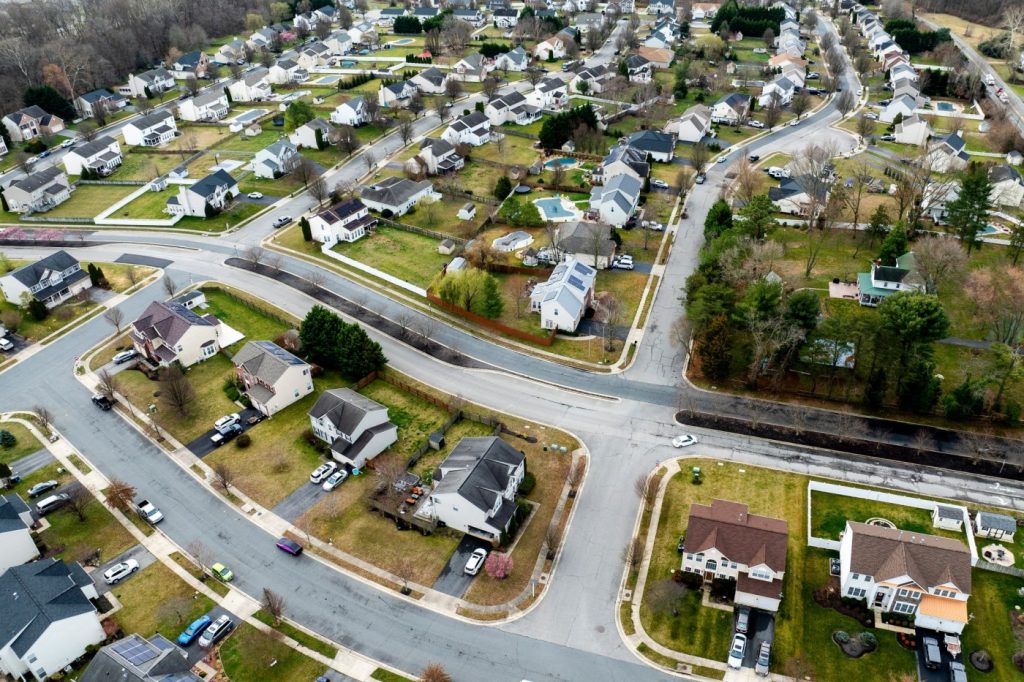Tim Henderson | Stateline.org (TNS)
Black homeowners’ property values are on the rise across the country, with some of the biggest upswings in Midwestern and Southern states. The boon to Black homeowners, after decades of lagging property values, could help them close a racial wealth gap that has kept the American dream out of reach.
Home values increased on average 84% in majority-Black ZIP codes between 2016 and 2023, outpacing growth in white ZIP codes, where values grew 69%, according to a Stateline analysis of federal housing and census data.
A hot market during the COVID-19 pandemic, an intensifying housing shortage, and new state and federal efforts to fight appraisal bias may finally be moving Black homeowners a bit toward property value parity.
Morgan Williams, an attorney for the National Fair Housing Alliance, an advocacy group, cautioned that the push for more fair housing appraisals remains in the early stages. And he noted that even unbiased appraisals can perpetuate undervalued housing by using past sales as a benchmark.
“There was, during the pandemic, an increase in Black wealth. There may be some broad policy actions you could trace that to, but I think a lot of that is going to be more housing-market driven,” Williams said.
Recent research has revealed that homes in majority-Black areas are more likely than those in majority-white areas to be appraised below purchase offers. The disparity remains high but has improved recently, according to federal statistics.
The Stateline analysis found that the home price increases in majority-Black neighborhoods since 2016 are a major shift from the prior 15 years.
Between 2000 and 2016, selling prices in majority-Black communities increased by 40% compared with 48% for majority-white areas, and home values fell in more than a fifth of Black ZIP codes.
Since 2016, however, home values increased in every majority-Black ZIP code tracked by the independent Federal Housing Finance Agency, and on average outpaced increases in white ZIP codes.
Stateline relied on that Federal Housing Finance Agency data on ZIP codes, which uses sales of similar properties — so-called matched pairs — to estimate price changes over time. U.S. Census Bureau estimates were used to find ZIP codes where most homeowners are Black.
In Detroit alone, rising home prices in Black neighborhoods have created almost $3 billion in new wealth for Black homeowners, according to a University of Michigan study released in April. That study focused on 2014 to 2022, the decade after the city’s bankruptcy. The Stateline analysis suggests the turnaround extends far beyond Detroit, across the Midwest and South.
The Stateline analysis identified 92 majority-Black ZIP codes nationally, including nine in Detroit and six in Cleveland, where home values have increased since 2016 after losing value earlier in the 2000s. There were 22 such ZIP codes in Georgia, 21 in Michigan, 17 in Ohio and 13 in Illinois, with others in Alabama, Connecticut, Florida, Indiana, Kentucky, Missouri, North Carolina, Tennessee and Wisconsin.
Another 48 majority-Black ZIP codes across the South and Midwest saw big property value increases of more than 100 percentage points. For instance, ZIP code 32811 in Orlando, Florida, saw 26% home price growth from 2000 to 2016, but that has ballooned to almost 215% in the years since.
Six of the top 10 turnarounds were in suburban Atlanta’s Clayton County, which got a boost when a long-vacant army base was redeveloped into the Gillem Logistics Center, an e-commerce and distribution hub that is projected to add 5,000 jobs and $4 billion into the local economy, said Erica Rocker, the county’s economic development director.
In Clayton County, a new four-bedroom home — with two Tesla chargers, an elevator and keyless doors — recently sold for almost $700,000. It had replaced a smaller home on the property that sold for $40,000 in 2020. The home’s ZIP code in Forest Park, 30297, had the nation’s largest swing in prices, going from a 27% loss to a 214% gain.
Altimese Dees, a real estate broker who has represented Clayton County in real estate and land acquisitions, said home values became artificially low in the Great Recession. Foreclosures sank the county’s average home price as low as $66,500 in 2009, but it has since recovered to about $253,000 this year, she said.
“We had a historic number of foreclosures between 2006 and 2011. Investors were basically getting these houses for pennies on the dollar,” Dees said. “It was a result of people losing their jobs and income during this time, as well as subprime lending targeting our mostly African American and minority community. We’re thankful for the increase in value, but it’s more like getting back to where it should be.”
A similar Stateline analysis in 2018 noted a drop in home values in many majority-Black ZIP codes. Some scholars concluded at the time that, despite the wealth-building potential of home ownership, many first-time Black homebuyers would have been better off renting.
In Detroit, resident Jelani Bayi bought his first home in 2021 in the city’s 48219 ZIP code, part of the Rosedale Park neighborhood. He feels like he’s building wealth for himself and preparing a place to raise a family when he’s ready.
“I definitely think it’s increased in value. I’ve put a lot of time and resources into the house, and values are increasing in Detroit,” Bayi said. “All my adult life I’ve always wanted to be a homeowner, and it was the right time. I just love it. It was very important to me to live in Detroit.”
Bayi said he took advantage of low interest rates in 2021 to buy his $275,000 four-bedroom brick home. Zillow estimates its current value at $316,200.
Sandra Newman, a Johns Hopkins University professor who studies housing and neighborhood change, said pandemic shifts toward suburban living and remote work may have brightened the fortunes of some Black neighborhoods.
“Price trajectories, especially for Black homeowners, depend heavily on location, location, location. The old real estate saw definitely applies,” Newman wrote in an email to Stateline.
Some states, including Mississippi, New Jersey and Texas, have tried to combat appraisal bias after recent cases made the extent of the problem clear.
In a California case, a Black couple sued after getting a dramatically higher appraisal when they “whitewashed” their home by adding family photos of a white family and removing African American art. After that, the appraisal increased by half a million dollars to nearly $1.5 million. The case was settled last year for an undisclosed amount.
In a similar Maryland case, a Black couple got an appraisal two-thirds higher when a white acquaintance posed as the owner of their Baltimore home. That case was settled in March for an undisclosed amount. A Black couple in Ohio also said they got a higher appraisal in 2020 after borrowing family photos from a white neighbor.
Because appraisals rely on personal judgment, many states are looking to diversify their ranks of appraisers. But an outmoded training system that includes thousands of hours of supervised work means many young would-be appraisers simply can’t find supervisors willing to help them get started.
Related Articles
Saturday’s detonation should free the ship that hit the Key Bridge. What’s next?
Should you be worried about bird flu? Here are 5 things to know about the virus
California job losses jump 20% in a year
Huge solar storm: Northern lights possible in California, sunspot visible with glasses
Taylor Swift debuts revamped ‘Eras Tour’ setlist with ‘Tortured Poets Department’ songs
However, in recent years, the racial gap in appraisals has narrowed in almost every state, according to a Federal Housing Finance Agency review published in April. It gauged the effect of a federal task force started in 2021 that “increased awareness of racial bias in home valuations” for states and other governments. The appraisal gap between homes in majority-Black and majority-white neighborhoods declined from 6% to 3.8%, the study found.
The gap closed in every state but Mississippi, which is working to diversify its appraiser workforce. E.C. Neelly IV, director of the Mississippi Appraisal Board, rejected the idea that white appraisers like himself are inherently unfair to Black homeowners.
“I’ve been an appraiser for 34 years, and if you pay an appraisal fee, I don’t care if you’re white, Black, pink or green, I’m doing a good job for you,” Neelly said.
Mississippi used federal funds to pay for alternative training that includes online courses, a move that should allow a more diverse group of would-be appraisers to get licenses. The first class had a high rate of success on licensing tests, and a second class is underway without federal funding, Neelly said.
“This has been just a godsend for the state. Every state is affected by this,” Neelly told Stateline, noting that most of the roughly 25 graduates of the program are non-white and from parts of the state, such as the Delta region, that desperately need more appraisers. The training program, designed and run by appraiser Melissa Bond, has drawn interest from other states interested in getting younger and more diverse appraisers, Neelly said.
“We need more diversity. It’s not just about Black. There are more Black appraisers than Asian, for example,” Bond told Stateline.
Texas recently adopted some online and virtual reality training to reduce an appraiser shortage and to diversify its crop of appraisers, and was the first state to treat appraisal bias cases as civil rights violations, said Melissa Tran, director of the state’s Appraiser Licensing and Certification Board.
And in New Jersey, Democratic Attorney General Matthew Platkin recently announced that state civil rights authorities would investigate appraisal bias there.
Stateline is part of States Newsroom, a national nonprofit news organization focused on state policy.
©2024 States Newsroom. Visit at stateline.org. Distributed by Tribune Content Agency, LLC.


